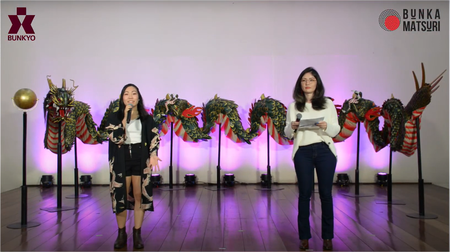Read Part 1 >>
Bunka Matsuri—Bunkyo’s Japanese Culture Festival
“The following year, I was invited to join the communications team at Bunka Matsuri to promote the movie Pokémon: Detective Pikachu. For me, it was a great challenge,” she acknowledges, “because until then I hadn’t been part of any commission that had such a major impact on the community.”

The Bunka Matsuri has always had a traditional format; however, from 2018 onwards it started to change, bringing in more [elements from the realm of] pop culture. In the eyes of this young Sansei, what prevailed was the fear of being daring.
“Over time, repeating what had been done 10 years earlier was the way to go for certain events. Now, the Geinosai [Japanese Folk Music and Dance Festival] is a traditional event because it consists of time-honored folk dances. But the other events need to be adapted to our reality—audiences are automatically looking for new things. If you have nothing new to offer, you become stuck in time,” asserts Graziela, now also vice president of the International Folk Dance Commission.
Also in 2019, “I received an invitation to join the Seinen board,” in the Communications and Marketing area. “From then on,” she says, “I became dedicated to the coordination of events like REVI (Revitalization)—National Forum for the Young Leaders of Institutions.”

REVI
At first a youth gathering, in 2001 REVI was turned into a youth leadership forum and it’s now the Youth Commission’s main event. It brings together more than 20 Brazilian seinen, and once one includes the Organizing Committee, the number of participants exceeds 100.
Traditionally, it was held at Bunkyo Kokushikan Park (formerly the Kokushikan Daigaku Sports Center) in São Roque (SP). But in 2019 the space was undergoing renovation due to the construction of the Kazuo Harazawa Pavilion. As a result, that year REVI took place at the Nippon Country Club in Arujá (SP). After being suspended because of the coronavirus pandemic, the renovation is expected to resume this year.

“That was the first time I took part in an event in a position of authority. I was shaking all over; I had no idea what I had to do. But—as I always say—what matters are the experiences you have once you participate in a youth group like this one; in this case, it was standing next to these important members of the community.” The opening was attended by Lidiane Yoshie Aoki, the CJB’s president in 2018; Letícia Yukimi Nakama, a member of the CJB; Graziela herself, who, along with the other two, coordinated the event; CJB President Guilherme Seigo Matsumoto; Nippon Country Club President Valter Sassaki; the Consul General of Japan in São Paulo at the time, Yasushi Noguchi; the former vice president of Bunkyo and president of the Kunito Miyasaka Foundation, Roberto Nishio; and Rodolfo Wada, the current president of the Youth Committee.
That year, the selected theme was “Where do you belong?” “When you join a group and you don’t feel like you’re in the right place, you don’t perform as well,” she explains. “Working on the question of belonging was what the girls and I figured would be the goal of that REVI gathering, so we could talk about one’s place in the group, where one feels welcomed, and where people accept you the way you are.”

“Onigiri was the ‘mascot’: several loose grains are one thing, but when you join them together, they become food, [they form] a basis. At the start [of the REVI forum], it was just one single onigiri (a person or a group) looking down from the top of the mountain. When it was over, there were a number of onigiri, for in the end everybody there comes together as one. We came up with this whole creative campaign so that it would have a beginning, a middle, and an end.” Its success was such that, whenever REVI is mentioned, onigiri is used as a reference. “These are ways for us to make it easy for people to remember the event,” she adds.
That was the most recent in-person edition. “As of 2020, we had to adapt and do it online.” Having overcome the obstacle of thinking about topics that would keep the participants engrossed, this event coordinator celebrates the success of REVIrtual.
The year ended with the live REVI presentation, which was held in partnership with seinen from [the southern state of] Rio Grande do Sul and [the Midwestern city of] Goiânia (which nowadays has an active younger staff), and addressed the issue of youth participation of different generations. She hopes that the debate “will serve as an inspiration to other groups, so they’ll also allow this exchange of experiences to take place.”
“Physically, the paths have become a little more distant; virtually, however, we managed to reach the Northeast, the North, the Midwest, and we took advantage of this moment to build relationships through other means,” the young leader reflects. “As a result of this scenario—these difficulties—we learned a lot. That’s why, if in a year like this we managed to get so much done, just imagine if we didn’t have the pandemic,” she concludes.

Sakura Matsuri—The Cherry Blossom Festival
Another challenge was the 2021 Sakura Matsuri, held at Bunkyo Kokushikan Park. It was conceived as an event amidst a pandemic, which could not lead to the agglomeration of people. The end result? Pre-scheduled drive-thru visits: a stop to take pictures in the woods, another near the gymnasium, and whoever had reserved a bento box would pick it up and eat its contents in the car. This was another idea that the Bunkyo board accepted from the younger crowd.
Despite the short time available, visitors enjoyed being able to leave the house for a while and spend some time in nature. “Being in a totally open space gives them more security,” she says. That’s why the most recent in-person events took place there.

Celso Mizumoto, Chairman of the Bunkyo Kokushikan Park Management Committee, is one of the great supporters of the young contributors, as he regularly participates in meetings and keeps an eye on the work being done. In this context, Graziela highlights a goal on which Bunkyo has been working these last few years: “These days, the CJB is involved not only in the management and organization of events but also in their planning and strategy. All this effort has been worthwhile because of the trust we have earned.”
After such dedication, Graziela—who was named Seinen Bunkyo’s vice president in 2020—is taking a major step in the community. “I’ll be assuming the presidency of the youth group this year. I’m now passing the baton so I can take over in February–March,” she reveals.
The contributions of the young
Currently, Bunkyo counts on the extensive role played by young collaborators, who have helped with everything related to the digital switch during the pandemic, when activities were no longer held in person. Bunka Matsuri at Home was the first live streaming matsuri and “one of the events that we had to learn the most to make it happen, as we had no guidance from anyone who had done it before,” she says.

Realizing that going digital is not as complex as it appeared to be, the board of this institution which is focused on Japanese culture has decided to invest more in such endeavors. Patience became the basis for the process of adaptation of the generation in command and for this union between the experience of the older folks and the knowledge of the younger ones.
The CJB had a notable participation in the Movimento Água no Feijão [which can be translated as the “More Beans in the Stew Movement”], a project conceived by Telma Shiraishi, chef at the Aizomê restaurant. Since the pandemic has exacerbated the hunger problem, this food industry professional took the initiative of calling on volunteers from the following organizations: JCI Brazil-Japan, Asebex (Brazilian Association of Former Scholarship Holders in Japan), Abeuni (Charitable University Alliance of São Paulo), Abjica (Association of Japanese International Cooperation Agency Scholarship Holders), Brazil-Japan Cultural Alliance, Bunkyo Youth Commission, and KIF Brazil (Koyamada International Foundation, founded by The Last Samurai actor Shin Koyamada). When it comes to social projects, this was one of the most successful in terms of uniting various groups in the community.

The work consisted of collecting food at partner markets and forwarding it to the school where lunchboxes were being prepared (a total of 63,000 in 2020), which were then delivered to the court area of the samba school Sociedade Imperador do Ipiranga, located in the South Zone of São Paulo. “I was able to participate on one of the last days of the project, when food baskets were also donated and we got to visit the community of Heliópolis [the city’s largest favela].” In Graziela’s view, it was an enriching experience in terms of the scope of the project and the fact that all those people joined forces to help others even though it was a delicate situation for everyone.

Being Nikkei
Graziela considers herself a Sansei, though she could be mistaken for a Nisei due to her constant presence in the Japanese community; besides, she identifies herself as Nikkei. She defines Nikkei as “a person who makes a contribution to the community, to the culture, in any way they can, by helping out at events or in the area of promotion, or by participating in some group, whether or not the person is a [Japanese] descendant.”
“When we do good, there should be no distinction between who is and who isn’t a descendant, since everyone helps out. Some can do a little more, others a little less, but the most important thing is helping from the heart and keeping the culture alive.”
A vision of the future
In the search for balance, it’s necessary to maintain traditional customs “because they’re part of history,” according to the third-generation Nikkei. “Knowing the origins—where everything that exists today came from, how it was in the past—is important for the adaptation to the present.”
“All this work and all these activities that we are doing and developing today are for the future as well. In fact, I feel that between the generations—the older ones, let’s say, the adults; and the younger ones—there was a break and people just weren’t all that interested in being part of something. That’s why we see [the differences between] an older generation and a younger one,” she says. “If we don’t do something now, there will be no one to keep it going. In other words, a culture and a history will be lost.”
And that’s exactly the role that this seinen plays. “I hope that the group can keep contributing more and more, helping the older ones not only at Bunkyo but in society in general.”
Experiences generate a whole assortment of lessons. “Stopping now would be a waste. The trend, then, is to keep going in other ways. Take me, for instance; I’d love to get closer to the kaikan of Okinawa and Hokkaido, as my family is their descendants. I’m sure that this baggage that I carry with me will be very important to help them in some way.” “We must continue to help—so we can have something to rely on further ahead—and to prepare future generations to take on what we’re doing today,” she concludes.
© 2022 Tatiana Maebuchi






